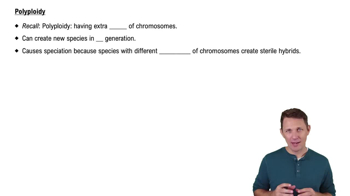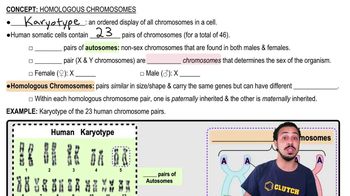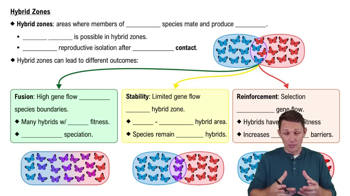Table of contents
- 1. Introduction to Biology2h 42m
- 2. Chemistry3h 40m
- 3. Water1h 26m
- 4. Biomolecules2h 23m
- 5. Cell Components2h 26m
- 6. The Membrane2h 31m
- 7. Energy and Metabolism2h 0m
- 8. Respiration2h 40m
- 9. Photosynthesis2h 49m
- 10. Cell Signaling59m
- 11. Cell Division2h 47m
- 12. Meiosis2h 0m
- 13. Mendelian Genetics4h 44m
- Introduction to Mendel's Experiments7m
- Genotype vs. Phenotype17m
- Punnett Squares13m
- Mendel's Experiments26m
- Mendel's Laws18m
- Monohybrid Crosses19m
- Test Crosses14m
- Dihybrid Crosses20m
- Punnett Square Probability26m
- Incomplete Dominance vs. Codominance20m
- Epistasis7m
- Non-Mendelian Genetics12m
- Pedigrees6m
- Autosomal Inheritance21m
- Sex-Linked Inheritance43m
- X-Inactivation9m
- 14. DNA Synthesis2h 27m
- 15. Gene Expression3h 20m
- 16. Regulation of Expression3h 31m
- Introduction to Regulation of Gene Expression13m
- Prokaryotic Gene Regulation via Operons27m
- The Lac Operon21m
- Glucose's Impact on Lac Operon25m
- The Trp Operon20m
- Review of the Lac Operon & Trp Operon11m
- Introduction to Eukaryotic Gene Regulation9m
- Eukaryotic Chromatin Modifications16m
- Eukaryotic Transcriptional Control22m
- Eukaryotic Post-Transcriptional Regulation28m
- Eukaryotic Post-Translational Regulation13m
- 17. Viruses37m
- 18. Biotechnology2h 58m
- 19. Genomics17m
- 20. Development1h 5m
- 21. Evolution3h 1m
- 22. Evolution of Populations3h 52m
- 23. Speciation1h 37m
- 24. History of Life on Earth2h 6m
- 25. Phylogeny2h 31m
- 26. Prokaryotes4h 59m
- 27. Protists1h 12m
- 28. Plants1h 22m
- 29. Fungi36m
- 30. Overview of Animals34m
- 31. Invertebrates1h 2m
- 32. Vertebrates50m
- 33. Plant Anatomy1h 3m
- 34. Vascular Plant Transport1h 2m
- 35. Soil37m
- 36. Plant Reproduction47m
- 37. Plant Sensation and Response1h 9m
- 38. Animal Form and Function1h 19m
- 39. Digestive System1h 10m
- 40. Circulatory System1h 57m
- 41. Immune System1h 12m
- 42. Osmoregulation and Excretion50m
- 43. Endocrine System1h 4m
- 44. Animal Reproduction1h 2m
- 45. Nervous System1h 55m
- 46. Sensory Systems46m
- 47. Muscle Systems23m
- 48. Ecology3h 11m
- Introduction to Ecology20m
- Biogeography14m
- Earth's Climate Patterns50m
- Introduction to Terrestrial Biomes10m
- Terrestrial Biomes: Near Equator13m
- Terrestrial Biomes: Temperate Regions10m
- Terrestrial Biomes: Northern Regions15m
- Introduction to Aquatic Biomes27m
- Freshwater Aquatic Biomes14m
- Marine Aquatic Biomes13m
- 49. Animal Behavior28m
- 50. Population Ecology3h 41m
- Introduction to Population Ecology28m
- Population Sampling Methods23m
- Life History12m
- Population Demography17m
- Factors Limiting Population Growth14m
- Introduction to Population Growth Models22m
- Linear Population Growth6m
- Exponential Population Growth29m
- Logistic Population Growth32m
- r/K Selection10m
- The Human Population22m
- 51. Community Ecology2h 46m
- Introduction to Community Ecology2m
- Introduction to Community Interactions9m
- Community Interactions: Competition (-/-)38m
- Community Interactions: Exploitation (+/-)23m
- Community Interactions: Mutualism (+/+) & Commensalism (+/0)9m
- Community Structure35m
- Community Dynamics26m
- Geographic Impact on Communities21m
- 52. Ecosystems2h 36m
- 53. Conservation Biology24m
12. Meiosis
Genes & Alleles
Problem 7`
Textbook Question
If one species (2n = 10) crosses with another species (2n = 18), producing an allopolyploid offspring, what is the ploidy of the offspring?
a. 2n = 10
b. 2n = 18
c. 2n = 10 + 18 = 28
d. 4n = 36 +20 = 56
 Verified step by step guidance
Verified step by step guidance1
Understand the concept of allopolyploidy: Allopolyploidy occurs when two different species interbreed, resulting in offspring with a combination of the parental species' chromosome sets.
Identify the chromosome numbers of the parent species: The first species has a diploid number of 2n=10, and the second species has a diploid number of 2n=18.
Determine the chromosome contribution from each parent: In an allopolyploid, the offspring typically receives one complete set of chromosomes from each parent species.
Calculate the total chromosome number in the offspring: Add the chromosome numbers from both parent species to find the total chromosome number in the offspring.
Consider the ploidy level: Since the offspring is an allopolyploid, it will have a ploidy level that is the sum of the chromosome sets from both parents, resulting in a new diploid number.
 Verified video answer for a similar problem:
Verified video answer for a similar problem:This video solution was recommended by our tutors as helpful for the problem above
Video duration:
3mPlay a video:
Was this helpful?
Key Concepts
Here are the essential concepts you must grasp in order to answer the question correctly.
Allopolyploidy
Allopolyploidy refers to the formation of a polyploid organism through the hybridization of two different species. This process involves the combination of the complete sets of chromosomes from each parent species, resulting in offspring with a higher chromosome number than either parent. It is a common mechanism in plant evolution, leading to new species with unique genetic combinations.
Recommended video:

Polyploidy
Chromosome Number
Chromosome number is the total count of chromosomes present in the nucleus of a cell. In diploid organisms, represented as 2n, chromosomes exist in pairs. When two species with different chromosome numbers cross, the resulting offspring's chromosome number is typically the sum of the two parent species' chromosome numbers, especially in cases of allopolyploidy.
Recommended video:
Guided course

Homologous Chromosomes
Hybridization
Hybridization is the process of crossing two genetically distinct species or varieties to produce offspring with traits from both parents. In the context of allopolyploidy, hybridization leads to the combination of different sets of chromosomes, creating a new organism with genetic material from both parent species. This can result in increased genetic diversity and novel characteristics in the offspring.
Recommended video:

Hybrid Zones
Related Videos
Related Practice












